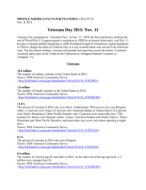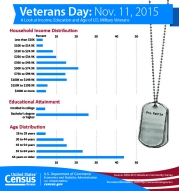"Veteran's Day 2015: Nov. 11, 2015"
Veterans Day originated as “Armistice Day” on Nov. 11, 1919, the first anniversary marking the end of World War I. Congress passed a resolution in 1926 for an annual observance, and Nov. 11 became a national holiday beginning in 1938. President Dwight D. Eisenhower signed legislation in 1954 to change the name to Veterans Day as a way to honor those who served in all American wars. The day honors military veterans with parades and speeches across the nation. A national ceremony takes place at the Tomb of the Unknowns at Arlington National Cemetery in Arlington, Va.
Graphic [PDF]
Veterans
19.3 million
The number of military veterans in the United States in 2014.
Source: 2014 American Community Survey
<//factfinder2.census.gov/bkmk/table/1.0/en/ACS/14_1YR/DP02>
1.6 million
The number of female veterans in the United States in 2014.
Source: 2014 American Community Survey
<//factfinder2.census.gov/bkmk/table/1.0/en/ACS/14_1YR/B21001>
11.4%
The percent of veterans in 2014 who were black. Additionally, 78.9 percent were non-Hispanic white; 1.5 percent were Asian; 0.7 percent were American Indian or Alaska Native; 0.2 percent were Native Hawaiian or Other Pacific Islander; and 1.2 percent were some other race. (The numbers for blacks, non-Hispanic whites, Asians, American Indians and Alaska Natives, Native Hawaiians and Other Pacific Islanders, and some other race cover only those reporting a single race.)
Source: 2014 American Community Survey
<//factfinder2.census.gov/bkmk/table/1.0/en/ACS/14_1YR/S2101>
6.1%
The percent of veterans in 2014 who were Hispanic.
Source: 2014 American Community Survey
<//factfinder2.census.gov/bkmk/table/1.0/en/ACS/14_1YR/S2101>
9.4 million
The number of veterans age 65 and older in 2014. At the other end of the age spectrum, 1.7 million were younger than 35.
Source: 2014 American Community Survey
<//factfinder2.census.gov/bkmk/table/1.0/en/ACS/14_1YR/B21001>
When They Served
7.0 million
The number of Vietnam War veterans in 2014. Moreover, there were 5.5 million who served during the Gulf War era (representing service from August 1990 to present); 1.1 million who served in World War II; 2.0 million who served in the Korean War; and 4.4 million who served in peacetime only.
Source: 2014 American Community Survey
<//factfinder2.census.gov/bkmk/table/1.0/en/ACS/14_1YR/B21002>
62,544
The number of living veterans in 2014 who served during the Vietnam War and both periods of the Gulf War (August 1990 to August 2001 and September 2001 or later).
Other living veterans in 2014 who served during three wartime periods:
- 36,396 served during World War II, the Korean War and the Vietnam War.
Number of living veterans in 2014 who served during two wartime periods:
- 1,059,546 served during the first part of the Gulf War (August 1990 to August 2001) and the second part (September 2001 or later).
- 284,985 served during the Gulf War (August 1990 to August 2001) and the Vietnam War.
- 161,768 served during the Korean War and the Vietnam War.
- 83,558 served during World War II and the Korean War.
Source: 2014 American Community Survey
<//factfinder2.census.gov/bkmk/table/1.0/en/ACS/14_1YR/B21002>
Where They Live
3
The number of states with 1 million or more veterans in 2014. These states were California (1.7 million), Texas (1.5 million) and Florida (1.5 million).
Source: 2014 American Community Survey
<//factfinder2.census.gov/bkmk/table/1.0/en/ACS/14_1YR/S2101/0100000US.04000>
Education
27.2%
The percent of veterans 25 years and older with a bachelor’s degree or higher in 2014. In comparison, 30.3 percent of nonveterans had a bachelor’s degree or higher.
Source: 2014 American Community Survey
<//factfinder2.census.gov/bkmk/table/1.0/en/ACS/14_1YR/S2101>
Income
$37,307
The annual median income of male veterans in 2014, compared with $32,433 for male nonveterans.
Source: 2014 American Community Survey
<//factfinder2.census.gov/bkmk/table/1.0/en/ACS/14_1YR/B21004>
$31,810
The annual median income of female veterans in 2014, compared with $21,804 for female nonveterans.
Source: 2014 American Community Survey
<//factfinder2.census.gov/bkmk/table/1.0/en/ACS/14_1YR/B21004>
On the Job
7.4 million
The number of veterans 18 to 64 years old in the labor force in 2014, of those 7.0 million were employed.
Source: 2014 American Community Survey
<//factfinder2.census.gov/bkmk/table/1.0/en/ACS/14_1YR/C21005>
Service-Connected Disabilities
3.8 million
The number of veterans with a service-connected disability rating in 2014. Of this number, 1.1 million had a rating of 70 percent or higher. A “service-connected” disability is one that was a result of a disease or injury incurred or aggravated during active military service. Severity of one’s disability is scaled from 0 to 100 percent, and eligibility for compensation depends on one’s rating.
Source: 2014 American Community Survey
<//factfinder2.census.gov/bkmk/table/1.0/en/ACS/14_1YR/B21100>
Voting
14.7 million
The number of veterans who voted in the 2012 presidential election. Seventy percent of veterans cast a ballot in that election, compared with 60.9 percent of nonveterans. These rates reflect the citizen population.
Source: Reported Voting and Registration, by Sex, Veteran Status, and Age: November 2012, Table 13
<//www.census.gov/hhes/www/socdemo/voting/publications/p20/2012/tables.html>
11.5 million
The number of veterans who voted in the 2014 congressional election. Fifty-four percent of veterans cast a ballot in that election, compared with 41 percent of nonveterans. These rates reflect the citizen population.
Source: Reported Voting and Registration, by Sex, Veteran Status, and Age: November 2014, Table 13
<//www.census.gov/hhes/www/socdemo/voting/publications/p20/2010/tables.html>
Business Owners
9.2%
The percentage of all U.S. nonfarm firms that are majority owned by veterans. Veteran-owned firms comprised an estimated 2.5 million of the 27.6 million nonfarm businesses nationwide in 2012. (Please note that the preliminary 2012 Survey of Business Owners data was used. The full data set will be released in December 2015.)
Source: 2012 Survey of Business Owners
<//www.census.gov/econ/sbo>
The following is a list of observances typically covered by the Census Bureau’s Facts for Features series:
| Black (African American) History Month (February) Super Bowl Valentine's Day (Feb. 14) Women's History Month (March) Irish-American Heritage Month (March)/ St. Patrick's Day (March 17) Earth Day (April 22) Asian/Pacific American Heritage Month (May) Older Americans Month (May) Mother's Day Hurricane Season Begins (June 1) Father's Day |
The Fourth of July (July 4) Anniversary of Americans With Disabilities Act (July 26) Back to School (August) Labor Day Grandparents Day Hispanic Heritage Month (Sept. 15-Oct. 15) Unmarried and Single Americans Week Halloween (Oct. 31) American Indian/Alaska Native Heritage Month (November) Veterans Day (Nov. 11) Thanksgiving Day The Holiday Season (December) |
Editor’s note: The preceding data were collected from a variety of sources and may be subject to sampling variability and other sources of error. Facts for Features are customarily released about two months before an observance in order to accommodate magazine production timelines. Questions or comments should be directed to the Census Bureau’s Public Information Office: telephone: 301-763-3030; or e-mail: [email protected].





